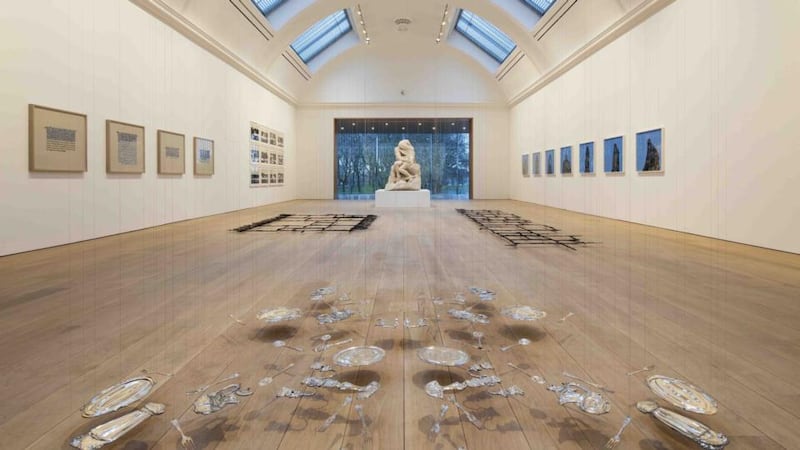Think of a university gallery of contemporary art in an Irish context and the Douglas Hyde and the Lewis Glucksman Gallery come to mind. With a student population approaching 40,000, the University of Manchester is several times larger than Trinity College Dublin or UCC. Stroll along Oxford Road from Manchester city centre and you soon realise the sheer scale of the place.
It also seems to go on forever, but persevere and eventually you’ll reach Whitworth Park and the formidable, slightly forbidding Edwardian facade of the university’s gallery, the Whitworth, which has just reopened following completion of a £15 million development.
The Whitworth first opened its doors in 1889 as the Whitworth Institute and Park. The name refers to Sir Joseph Whitworth, who had died a couple of years previously, aged 83, and was a significant benefactor to Manchester. A gifted engineer and entrepreneur, his many achievements include a system for standardising screw threads and a lethally accurate rifle barrel.

The building was completed in 1908. From the beginning, its collections acknowledged Manchester's manufacturing pedigree. Textiles were, and remain, every bit as important as fine art. Fast-forward to 1958 and the university assumed control of the gallery and added an extension, designed by Richard Bickerdyke.
The university has remained aware of the significance of manufacturing with, for example, an important collection of wallpapers. The latest addition is a little outside the conventional definition. Sarah Lucas designed it in 2000 and it features sculptural forms shaped from cigarettes and is helpfully titled Tits in Space, just in case you doubt your eyes.
Two new wings
McInnes Usher McKnight Architects approached the site with real tact, even modesty. Rather than trying to impose a grand statement on or beside the existing structure, they've rehabilitated it to great effect and carefully opened it out to the rear, throwing out two new wings – or arms – into the parkland, one a dramatic cantilever, dramatically enhancing visibility from and into the gallery. It was a complicated process, one that took at least six months longer than envisaged, and one of the two gardens that form part of the plan, Sarah Price's Art Garden, has yet to be completed.
Even purely in terms of rehabilitation, the gains are amazing. For one thing, the removal of false ceilings has revealed the exceptional character of a central arrangement of barrel-vaulted galleries, giving them an entirely new lease of life.
What has been added is equally impressive, as much for attention to detail and materials as for practicality. It’s a very interesting, inviting building to negotiate, with a warm, friendly feeling, a succession of good spaces and aspects, and a continual engagement with the parkland; the cafe, for example, occupies one of the new wings, so that you’re out among the trees, or directly overlooking a garden, when you’re in it.
The barrel-vaulted galleries are given over to Cornelia Parker, with two monumental installations, plus many smaller though still substantial works on view (until May 31st).
Parker is best known for one extraordinary installation piece, Cold Dark Matter: An Exploded View, originally exhibited in London in 1991. It's the centrepiece at the Whitworth and, as more than one observer noted, it's the perfect artwork to launch a building that's been symbolically, beneficially exploded.
To make it, she asked the British army to blow up a garden shed for her. Then she gathered up the pieces and painstakingly suspended them in mid-air, caught in the instant of explosion and disintegration. A central light projects myriad shadows outwards. It's one of those pieces of contemporary art that even people who say they don't get contemporary art tend to like when they see it. And with reason. Simple in conception, it's spectacular in the flesh and rich in association. It also fits in a tradition of auto-destructive art most famously pioneered by Jean Tinguely.
The other major installation is subtler, though not in the same classical league. Parker acquired the material from which the Remembrance Day poppies were cut. Draped through the interior of one of the galleries, they form a vast red tent, with each blank space representing a life lost. Her work is notable for its combination of attention to tiny detail married to a grasp of overall vision, the one often rooted in the other.
The space has doubled
Exhibition space has doubled overall. Even so, with a commitment to delivering a substantial temporary exhibitions programme and a responsibility to a collection numbering 55,000 pieces, the Whitworth has its work cut out.
It also has a reputation to live up to. Go back through the decades and it pioneered the work of several major UK artists, including David Hockney, and was known as the "Tate of the north". It also addresses several communities, not just academics and students, but the wider Manchester community. And, as has often been remarked, the gallery is almost in Moss Side.
Director Maria Balshaw seems more than up to the challenge. She's also responsible for the municipal gallery just up the road. Get over the first impression of an Edwardian institution – it will be softened by a sculpture garden apparently – and things just get better and better.
Opening exhibitions include Cornelia Parker, Cai Guo-Quing (until June 21st), 90 New Acquisitions gifted by the Karpidas Foundation (until August 16th) and more


